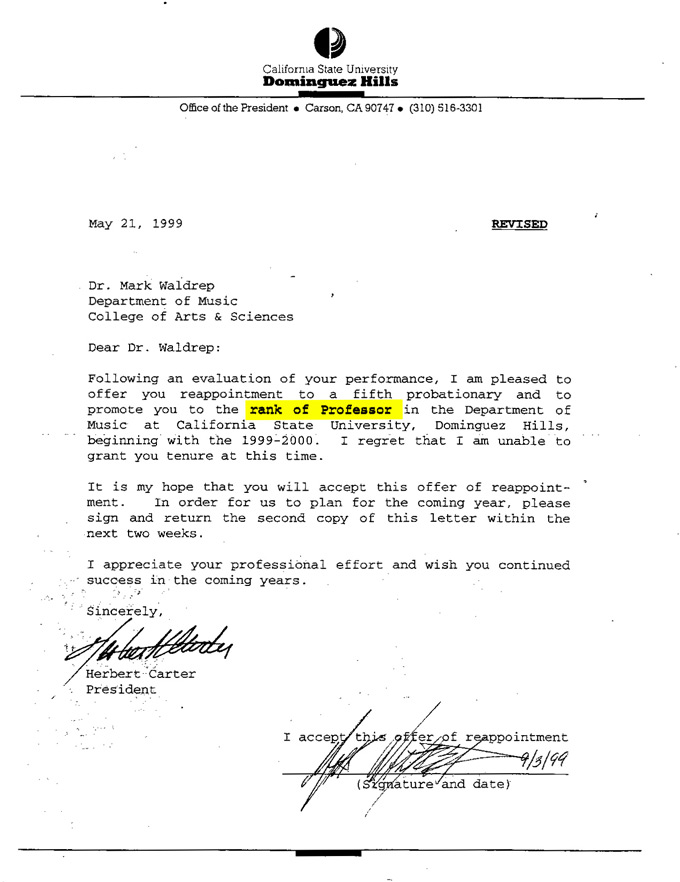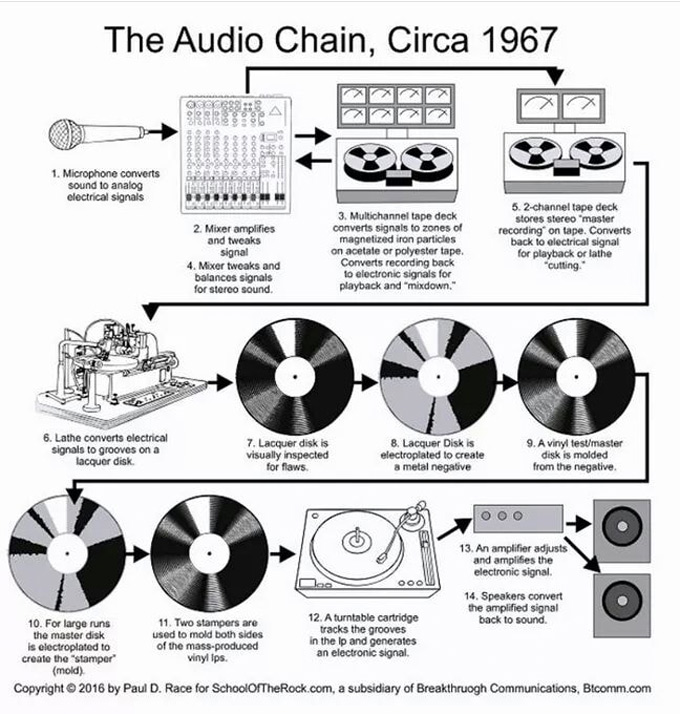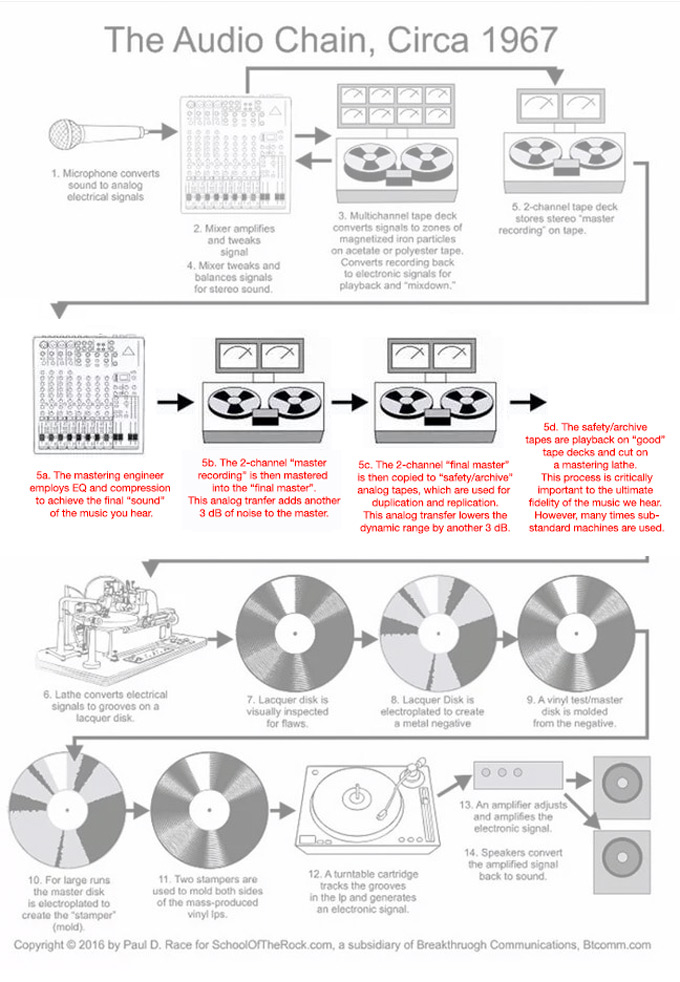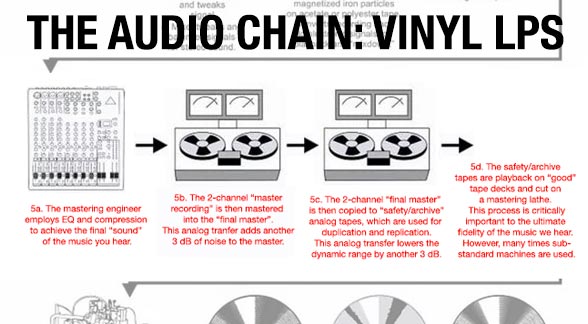The Audio Chain: Classic Vinyl
A New Semester — and An Old Problem!
A new semester begins on Monday at CSU Dominguez Hills tomorrow. I’ve taught audio recording, digital media, and production for over 25 years at this institution and have enjoyed working with students all of those years. But this fall I’m on sabbatical. I’m off and charged with completely my research project. And I have to acknowledge that it feels a little bit strange not to be gearing up for a new term, not to be introducing myself to 40-50 new students, and reengage with those returning for their second — and final — year.
Never mind that I’ve been fighting with my university for almost 2 years over my promotion to full professor in 1999 by the president and the unfortunate fact that they never advanced my rank from associate professor or paid me the additional salary afforded full professors. While you might think — and certainly hope — that the university would “rectify the mistake” and make me whole after underpaying me for almost 20 years, you would be wrong! From the discovery that they made a mistake and a formal grievance submitted by the faculty union, the university administration, personnel office, and representatives from the chancellor’s office have denied obvious facts, delayed the resolution process at every turn, and asserted that the signed letter I received from the university president congratulating me on my promotion in May of 1999 was not valid because he wasn’t allowed to promote me according to the collective bargaining agreement at the time — something I was supposed to know. It’s unbelievable that seemingly intelligent and decent people steadfastly refuse to do what’s right and fair. I wonder how anyone one of them would feel if the shoe were on the other foot. What would they do if they were promoted only to learn that the information never got to the personnel office after so many years? Would they feel cheated and treated poorly? So I’m forced to continue fighting. And with each passing day and week and year, any goodwill I once had for the institution and department that I have given so much to has been squandered. It’s really sad but seems typical in today’s abusive climate.

Making Vinyl LP Sausage
I noticed the diagram below on one of the FB groups I follow last week and posted a comment pointing out several errors that make the ultimate fidelity of a vinyl LP worse than the diagram indicates. So I decided I would start a series of blog posts on “The Audio Chain” associated with a few of the major delivery formats currently used in music distribution. Today, it’s vinyl LPs. It’s important that music lovers and audiophiles understand the production process of a particular format before playing it on your own system. Fidelity is either maximized and maintained OR diminished in each production step prior to distribution. I created a large chart some years ago but due to a failed power supply on my other Mac, I can’t share that with you this morning. I’ve ordered a new PS and will get that illustration asap.
First, here’s the diagram that was presented on the FB page.

The chain presented above maintains the audio signal in the analog domain from the initial acoustic to electrical energy conversion at the microphone to the conversion back to acoustic energy at the speakers. It’s a marvel of science and technology that the fidelity of the final vinyl LP playback closely — or not so closely — approximates the initial musical performance. My own comments on the FB page added two additional analog transfer stages which I’ve inserted into the diagram below:

Each time you make an analog tape copy, the fidelity of the copy is reduced at least 3 dB. The noise floor comes up and additional distortion is introduced. It’s just the nature of the analog process. And there are a whole bunch of other problems that loom large in the analog tape world (which many advocates in the reel-to-reel market are unaware of or choose to conveniently ignore). Careful alignments must be regularly performed — both physical and electrical — on every component. The head stack, the tape path, the repro EQ, and reel tension are critical to getting the best performance out of every tape deck. Sadly, virtually all analog reel to reel tape machines — even studio machines — are woefully inadequate when it comes to making these transfers. And don’t even think that you’re home deck is up to the task! Yet, analog reel to reel decks and prerecorded tapes are selling for huge prices! Go figure. And remember vinyl LP compound the problems through additional production steps!
The diagram above should cause vinyl LP lovers to pause and wonder if there might not be a better way to capture and reproduce music. And of course, it turns out there is. One that has much greater potential fidelity, costs less, and is way more convenient — PCM digital. But admittedly audiophiles continue to favor and spend money on turntables and LPs. Even crazy money, in the hundreds of thousands of dollars, is being spent on exotic machinery. Are rich audiophiles really that stupid? Look at all of the compromising steps that happen before you drop the needle into the lead-in groove. The press, audiophile societies, artists, and equipment manufacturers perpetuate the myth of vinyl because its cool and makes them lots of money. Wouldn’t it be nice if accuracy and fidelity really mattered?
The fidelity of reproduced music is “locked” in at the time of the final mastering. In the classic vinyl LP days, the master was a 1/4″ stereo analog tape. If you could sit in the mastering studio and hear that first generation master, you’d actually be hearing what the “artist intended” — or at least approved. Any subsequent processing, copying, lacquer cutting, metalizing, stamping, or electroplating decreases the fidelity of the master. Any vinyl LP pressing must accept the limitations of the format and is a faint reminder of the original master delivered by the mastering engineer. Advocates for vinyl confuse fidelity with subjective preference. They are not the same thing.
AIX Records Back to School Sale – Get 35% OFF
The AIX Records website has launched and is accepting orders for both physical discs AND the option to add-on downloadable high-resolution files. I’ve activated a COUPON (BTS2019) for 35% OFF all AIX Records products through the end of September for those looking to add to their collection of AIX titles.

You can click on the image above or visit AIX Records to take advantage of this special offer.
Fun Fact In AIX Music Streaming
Some months ago, I made a deal with a close friend to make the AIX Records catalog available to the streaming world. He’s taking care of the ingestion, metadata tagging, etc. I didn’t hold out much hope for a real financial upside. Revenue from streaming is notoriously low. So when I asked for a report on the first few months, I was blown away by the spreadsheet showing a $5000 payment from Pandora! Wow! I had to wonder which recording would be so popular? Was it one of our best selling albums like Laurence Juber’s Guitar Noir or Nitty Gritty Surround with John McEuen and Jennifer Warnes? Maybe The Latin Jazz Trio? Nope. The album that generated 95% of the payment from Pandora is Mark Chesnutt’s Your Room believe it or not.
It’s surprising because anytime I demoed a track by country legend (and multiplatinum artist) Mark Chesnutt at the AXPONA show, virtually all audience members would head for the door. Apparently, country music and audiophile sensibilities don’t mix. But listeners on Pandora made Mark Chesnutt’s album pay off big time for AIX Records.


You’re still too generous to vinyl. A few more inserts are needed:
The mixing of the bass to mono,
The nrolling the bass off to save space with the notoriously non-standardized RIAA curve which was Implemented differntly by different studios,
The only sometimes-symmetrical RIAA eq on playback by a fixed circuit in the player.
Not to mention surface noise and damage not only from scratches but also from replaying a disk before the vinyl has had a chance to spring back from being compressed by the needle, leading to shaving off of the details of the groove.
Vinyl adherents have “imprinted” on the style of sound they grew up on, much like baby ducks who mistake a passerby for their mother. Vinyl is not the original sound but merely the first version they got used to.
Thanks Phil for enumerating the “limitations of the format” of vinyl LPs. Yes, it’s actually a really miserable method of storing and reproducing music but has found a place in the marketplace.
Seeing that diagram (“The Audio Chain, Circa 1967”) one wonders what is the truth behind statements like: “From the original master tapes” or “From the original analog tape masters” and so on.
Labels like DCC, Audio Fidelity, MFSL and recently non audiophil labels (SONY, Universal etc.) repeatedly used that term.
In the 1980s there was that Beatles Box set by MFSL
(link: https://en.wikipedia.org/wiki/The_Beatles:_The_Collection) with photos of the master tape boxes. Judging from the diagram, it seems they used copy tapes.
Several years ago prior to a lecture demonstration I participated in at Jungle Studios, I was given a tour of Battery Studios. They specialize in restoring and remastering older classic albums. The engineers acknowledged that they rarely find or have access to the original master tapes. Instead they must use copies sourced from all over the world. The major labels are usually unable to get the real masters. And any tapes they do use are poorly transferred.
An untenured full professor on sabbatical… never heard of such a thing! I’d’ve left years ago… I hope that “untenured” part doesn’t bite you on the ass someday. Glad you got a sabbatical, though, those are wonderful.
I’d also add the RIAA equalization stages to your diagram above as well, which of course introduce phase and amplitude errors. And then you have off-centered pressings (drives me bonkers) and speed variations etc….
It’s a small wonder vinyl can sound good at all, but it can. I find myself only listening to certain bands on vinyl for mostly nostalgic reasons, and digital for the rest. Occasionally I have friends come over and we spin our vinyl just for the hell of it. But my collection, as it were, of a couple hundred albums isn’t really growing much any more. Format fetishism only takes you so far. Listening to music is not just about the sound for many people!
Leigh, there’s a lot more to the university story than I wrote. I was granted the promotion early and tenure two years later. Until 2017, I was under the impression that the paperwork that I received from the administration was valid — and that I was indeed a full professor. They never informed me otherwise.
The imperfections of vinyl LPs are well known. Even the best 180 gram specialty pressings must conform to the format with the folded low frequencies, inconsistencies of the RIAA stuff (the curve is not defined past 20 kHz), and a myriad of other flaws. Yet, everyday someone revels in the sound of vinyl LPs as being “better” than digital.
I just discovered that someone posted your updated diagram of The Audio Chain, circa 1967 on the Steve Hoffman forum (see post # 2414: https://forums.stevehoffman.tv/threads/the-day-the-music-burned-article.849828/page-97#post-21969900).
The replies are not that favorable … .
Thanks, I’m not surprised. There are a lot of audiophiles and enthusiasts that are unable to understand — and accept — facts when presented. As a professional engineer for over 40 years and someone that lived and worked with analog and vinyl LPs, I stand by my post. I’m not going to bother to visit Steve’s forum.
Mark,
I have enjoyed the couple of times I have spent with you discussing audio, most notably at the latest California Audio Show. I also own a number of your fine recordings. But you sure like to beat this vinyl dead horse to a pulp.
I will admit I have one of those ridiculously priced turntable/tonearm/cartridge combinations. I also have a damn fine dac, the Bricasti M1SE. You have spent years in the recording studio listening to master tapes. I wish I could have had the same experience. You would know far better than me what is most accurate to the master. But having spent the last 40 years attending hundreds of concerts in Carnegie Hall and Philly’s Verizon Hall I maintain that my vinyl (which is cleaned and kept in mostly pristine condition) sounds, in many cases, more like the real thing to my ears. You are correct, this is my preference. I have no way of knowing whether it is accurate or not. But whether it is analog or digital, both pale to listening to the real thing in a large hall.